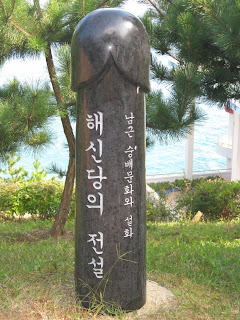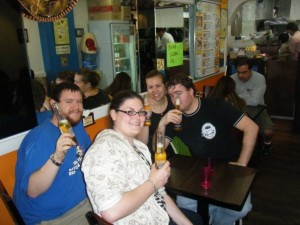Author’s note: There’s bound to be updates to this month’s events – keep checking back for more information and new events! If you have an event you’d like to plug, comment on this post or contact me with all the details. Please follow a few guidelines for the maximum benefit.
April 6 – May 29: Cirque du Soleil Varekei has finally made its way to Seoul after having toured much of the rest of the world – it opened in Montreal in 2002, although it’s just now coming to Asia. If you’ve ever wanted to feel awed and amazed without attempting illegal narcotics, this is easily the best way to do it. While not worth the price of admission alone, Irina Naumenko bends her way into some extraordinary positions to ‘save’ our man Icarus. Cirque du Soleil takes the best forms of human talent, harnesses them into a spectacle, and leaves an unforgettable night permanently embedded in your memory. Jamsil Sports Complex, 60,000 – 220,000 won a seat. For more information, check out http://www.varekai.co.kr/sub_6_4.php or call Interpark at 02-1544-1555.
April 29 – May 10: the Hampyeong Butterfly Festival – it doesn’t seem to rank high among the foreigners (Brian’s review from two years ago was less than praiseworthy), but it’s considered one of the best festivals by Visit Korea. It’s about half an hour from Gwangju, so it’s not too far from civilization.
May 1 (9:00am-12pm): History comes alive in Seoul everyday, but today is a once-a-year celebration. It’s the Jongmyo Daeje – the ceremony honoring the spirits of the former kings and queens. Starts at Gyeongbokgung downtown, then parades its way to the Jongmyo Shrine. Learn more through an official tourist website.
May 3-8: Damyang Bamboo Festival: Enjoy the power of bamboo – what can wood do for you? The Damyang Bamboo Festival organizes hands-on programs for families, offering an experience in ecology and culture. Visitors can walk in the bamboo groves, ride on a bamboo raft, or shoot a bamboo arrow. A variety of performances will be staged, including a bamboo dance. The festival ends with a ceremonial fire fueled with bamboo. Learn more at bamboofestival.co.kr, or check out my recent trip to Damyang.
May 3-7: Herbs, anyone? The Daegu Yangyeongsi Herb Medicine Festival may be a good chance to learn more about the local herbal culture. The nearby museum is fun as well – quite a bit of information in English – and is worth stopping by if you’re in the area.
May 4-8: Hadong Wild Tea Cultural Festival - not sure what’s so cultural about wild tea, but Visit Korea says it is “showcasing a variety of programs including handpicking green tea leaves, participating in a traditional tea ceremony and making traditional tea bowls.” It looks like a really pretty area, however – and a good excuse to get out of town. Learn more at Visit Korea.
May 4-8: now here’s a new one – Yeoncheon Jeongok-ri Paleolithic Festival – held in Gyeonggi-do near the site of some Paleolithic ruins. Sure, there are several other festivals happening this weekend, but this one is closest to Seoul, if that makes a difference. Learn about the history of humans, and check out the Visit Korea page for more information.
May 5-10: Hi Seoul Festival – thanks to a budget cutback, the extravagance of previous years is making way for more performance-based art. The non-verbal theme will fit nicely with the goal of attracting an international audience, and quite a few well-known attractions, including NANTA, circus performances, and puppets. Attractions are scattered around Yeouido Hangang Park, Seoul Square (across from Seoul Station), and Cheonggye Square. For more information, check out the official English-language site.
May 6-8: World DJ Festival – it’s so popular, Seoul can’t contain it. The newer, bigger venue in Yangpyeong (eastern Gyeonggi-do, closest to Yangpyeong station on the Jungang line) Performing this weekend: Dada Life (Sweden), Blatta & Inesha (Italy), D’Jamency (France), Jesse Jamz (USA), Freemasons (UK), Lazy Rich (Canada), Will Bailey (UK), Shut Da Mouth (Korea), 2E Love, House Rulez, Oriental Funk Stew, Freakhouze, East Collective, Clubber Langz, DJ Shai, UJN & Nova, MazestiK aka InnuRoh, Roem, Triple House, Soolee, Inside Core, Limzi, DJ AB, Bada Lehner, Mackay, Planet Shiver, DJ Rubato, Lee Sangeun, Wiretap in My Ear, Guckasten, Dok2, The Quiett, Rude Paper, Garion, 45 rpm, Soul Company, DJ INgram, DJ Nega, DJ Pandol, The Z, and many more. Seven stages. Their site has an English section, as well as a Facebook page.
May 7: pick something up from the First Saturday Flea Market, put on by the Seorae Global Village Center. If you have something to sell, registration is free, but must be done by the DAY BEFORE. Call 02-2155-8915 or email [email protected] to learn more.
May 7: Mozart “Requiem”, Quintana’s “Mass From Two Worlds”. Mozart’s last and unfinished work was completed by one of his students. Enjoy it because it’s beautiful classical music reminding us of our mortality, or because you’d prefer to get away from the Hongdae / Itaewon crowds for a night. 15,000 in advance, 25,000 at the door. Chung-dong First Methodist Church near City Hall. Learn more at Camarata Music Company’s website.
May 7-8 (12pm-8:30pm): Make some new chingu at the Seoul Friendship Fair. While the official offerings are everything from performances and art to street events, the World Food Court is perhaps the best reason to go. Don’t even think about eating before you come – there are dozens of food trucks, each offering respective country’s delicacies. Alcohol from around the world is around to help you wash it down as well. Seoul Plaza (i.e. that big piece of grass in front of City Hall).
May 11-14: The World IT show – because you know your inner geek needs to come out and see what’s happening in the real world every now and then. COEX mall, halls A, C, and D. http://www.worlditshow.co.kr/eng/
May 14-15: 2nd Green Plugged Festival. Jaurim, Crying Nut, No Brain, Lee Han Choul, Huckleberry Finn, Tacopy, Paris Match (Japan), Superkidd, Mongni, Guckkasten, Ibadi, W&Whale, Winterplay, Daybreak, Lee Jang Hyuk, Lee JiHyung, Sohee, Anyang Bada, Dearcloud, Ynot?, Galaxy Express, Common Ground, Serengeti, Eve, Wiretap in My Ear, Naru, Gogo Star, Yaya, Soran, Dot, Ruby Star, and many more. 88,000 won sounds like a lot, but you know how much it costs to feed those musicians, not to mention new guitar strings and drumsticks. See http://greenplugged.com/ for more.
May 14: Time for a Flash Freeze with Improv Korea! Starting around 4:30pm in Insa-dong, be prepared to freeze in place, not meet anyone before-hand, and create a scene for the enjoyment of locals! Wear red and be prepared to have a good time! For more information, check out the Facebook event page.
May 14: Belly dancing! Specifically, the World Bellydancing Day Korea. Plenty of bellies moving around in classic fashion, raising money for Korean Women’s Association United (KWAU) and Korea Sexual Violence Relief Center (KSVRC). An amateur show is at 5pm (admission: 5,000 won), while a two-hour show of professionals starts at 7pm (admission: 44,000 won). Oriental House Theater in Seongbuk-gu. See the Facebook event page for more.
May 21: it’s that time of year again – the Haebangchon Festival returns to central Seoul. The twice-a-year indie music festival features the local artists of Haebangchon. They’re not world-famous names, but the atmosphere is convivial and full of energy. For more information, check out the official website.
May 22-29: Chuncheon Mime Festival – all jokes aside, this is becoming more internationally recognized, and performers will hail from around the world. For more information, check out the official page.
May 26-29: The Ulsan Whale Festival – unless you’re interesting in building ships, you probably haven’t had a reason to visit Ulsan until now. Check out the traditional whale fishing, a whale singing competition, and my favorite, the whale cake-making. This sounds a lot like a county fair back in the US. Don’t forget about making whale ice sculptures… in May… For more information, check out the official English website.
May 28, June 4, and June 11: You Are Not Alone: Cabaret for Good will run for 3 Saturday nights at 8:00 pm at Club After Mainstage in Itaewon. This show, in addition to being a lot of fun for performers and audience, will be a fundraiser for three charities – Habitat for Humanity, the House of Sharing, and Japan disaster relief. Plenty of classics and songs you’ll probably be singing along with – and the won goes to a good cause. For more information, check out seoulplayers.com.
May 31 (DEADLINE): DEADLINE for play submissions, director applications, and collaborative project proposals
Date: MAY 31 2011. Email to info AT seoulplayers.com with TEN MINUTE PLAY FESTIVAL SUBMISSION in the subject
DIRECTORS – please submit a resume and a paragraph or two detailing your directing style and what you’d hope to get out of directing for the festival. First time directors are encouraged to apply! DEADLINE: May 31, 2011
PLAYWRIGHTS – plays must be 10 minutes or shorter. You may submit 1 or 2 plays. DEADLINE: MAY 31, 2011
 © Chris Backe – 2011
© Chris Backe – 2011
This post was originally published on my blog ,Chris in South Korea. If you are reading this on another website and there is no linkback or credit given, you are reading an UNAUTHORIZED FEED.
|
|
2nd Green Plugged Festival. Jaurim, Crying Nut, No Brain, Lee Han Choul, Huckleberry Finn, Tacopy, Paris Match (Japan), Superkidd, Mongni, Guckkasten, Ibadi, W&Whale, Winterplay, Daybreak, Lee Jang Hyuk, Lee JiHyung, Sohee, Anyang Bada, Dearcloud, Ynot?, Galaxy Express, Common Ground, Serengeti, Eve, Wiretap in My Ear, Naru, Gogo Star, Yaya, Soran, Dot, Ruby Star, and many more. |
![]()




 RSS Feed
RSS Feed































































































Recent comments